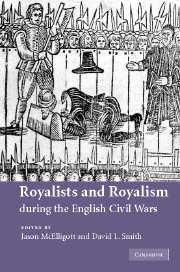Book contents
- Frontmatter
- Contents
- Notes on contributors
- Preface
- Abbreviations
- 1 Introduction: rethinking royalists and royalism
- 2 A lesson in loyalty: Charles I and the Short Parliament
- 3 The Court and the emergence of a royalist party
- 4 Varieties of royalism
- 5 Royalist reputations: the Cavalier ideal and the reality
- 6 Counsel and cabal in the king's party, 1642–1646
- 7 ‘I doe desire to be rightly vnderstood’: rhetorical strategies in the letters of Charles I
- 8 Royalists and the New Model Army in 1647: circumstance, principle and compromise
- 9 The royalist origins of the separation of powers
- 10 ‘A No-King, or a New’. Royalists and the succession, 1648–1649
- 11 The royalism of Andrew Marvell
- Subject Index
- Author Index
9 - The royalist origins of the separation of powers
Published online by Cambridge University Press: 19 July 2009
- Frontmatter
- Contents
- Notes on contributors
- Preface
- Abbreviations
- 1 Introduction: rethinking royalists and royalism
- 2 A lesson in loyalty: Charles I and the Short Parliament
- 3 The Court and the emergence of a royalist party
- 4 Varieties of royalism
- 5 Royalist reputations: the Cavalier ideal and the reality
- 6 Counsel and cabal in the king's party, 1642–1646
- 7 ‘I doe desire to be rightly vnderstood’: rhetorical strategies in the letters of Charles I
- 8 Royalists and the New Model Army in 1647: circumstance, principle and compromise
- 9 The royalist origins of the separation of powers
- 10 ‘A No-King, or a New’. Royalists and the succession, 1648–1649
- 11 The royalism of Andrew Marvell
- Subject Index
- Author Index
Summary
Of all political notions floating about the seventeenth century, perhaps the most seductive was the sovereignty of parliament. By that idea is meant precisely this: that parliament is the final arbiter of whatever is undertaken by the monarch and nation, and the actions of the executive and the judges are subject to parliament's rule and, if need be, reversal. Such a view had its sixteenth-century origins, before Jean Bodin elevated the concept of ‘sovereignty’ itself to a political commonplace. Famously, Henry VIII himself said his ‘estate royal’ was greatest ‘in the time of Parliament’; Sir Thomas Smith held the parliament was the ‘most high and absolute power of the realme’. Whether, though, the notion of parliamentary sovereignty was mere political boilerplate or a contentious and, indeed, a revolutionary doctrine depended entirely upon what one held to be the composition of a parliament. Both Henry and Smith – and, following them, the overwhelming preponderance of informed pre-Civil War opinion – thought a parliament included the king as a fundamental part. Without the king, the two houses were no parliament. Yet common if unthinking usage held that the Lords and Commons alone constituted the parliament. King versus parliament, royalists versus Roundheads – sophistications or sophistries aside, that was what the conflict seemed to be about.
Of course, those self-serving and conscience-assuaging equivocations had their uses.
- Type
- Chapter
- Information
- Royalists and Royalism during the English Civil Wars , pp. 175 - 191Publisher: Cambridge University PressPrint publication year: 2007



